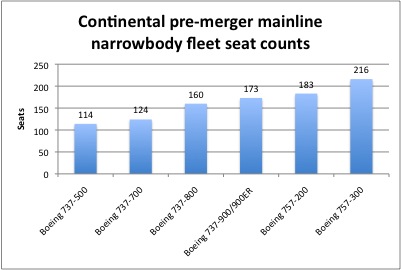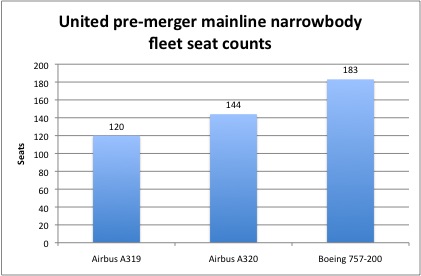United Airlines faced quite the juggling act during the past year.
Network planners at the Chicago-based Star Alliance member took the bulk of the former United and former Continental Airlines fleets - totalling 702 mainline and 551 regional aircraft at the end of 2012 - and integrated them so that the right aircraft were flying the right routes at the right times. Optimisation was the name of the game.
"[You] interweave the right aircraft at those hubs so that you optimise the number seats at a specific time," says Brian Znotins, vice-president of network at United. As an example, he points out the gap in the pre-merger United's narrowbody fleet between its 138-144 seat Airbus A320s and about 180-seat Boeing 757-200s, and in the pre-merger Continental Airlines narrowbody fleet between its 124-seat Boeing 737-700s and its 160-seat 737-800s.

Flightglobal Research

Flightglobal Research
Redeployment allowed United to fill those gaps with the variety of aircraft types in its combined fleet. Following the reconfiguration of legacy Continental aircraft with an economy plus seating option, it now has 114-seat 737-500s, 120-seat A319s, 124-seat 737-700s, 144-seat A320s, 152-160 seat 737-800s and 167-173 seat 737-900/900ERs.

Flightglobal Research
"The general benefit is really the aggregate of those one and two seat differences," says Znotins.
United began redeloying aircraft immediately after the merger with Continental closed in October 2010. The carrier filled in the gaps between the two systems, for example launching flights between Chicago O'Hare and Fort Lauderdale, and shifted some widebody aircraft to better match demand, for example upgauging flights between Houston Intercontinental and Lima to a United metal Boeing 767-300ER from a Continental metal 757-200, during the first quarter of 2011. However, the bulk of the optimisation took place during 2012.
It is common now for passengers to see a 737 at San Francisco or Washington Dulles (former United hubs), or an A320 at Intercontinental or Newark (former Continental hubs). United opened 737 crew bases at O'Hare, Denver and Los Angeles, and A320 family bases at Houston as part of these moves during the past year.
One of United's headline moves was the concentration of its Boeing 747-400 fleet at San Francisco. Flights from Chicago to Hong Kong and Tokyo Narita are being downgauged to Boeing 777-200s while flights from San Francisco to Frankfurt, London Heathrow, Osaka Kansai and Taipei will be upgauged to 747s as a part of the shift. The shift will be complete by the second quarter.
Znotin says that while many of the narrowbody redeployments were done for operational reasons, the 747s were shifted to San Francisco in order to create maintenance efficiencies.
Redeployment is largely complete. Znotin says that United has reached the point that it envisioned when the merger occurred in 2010, though he notes there will always be some changes as demand shifts. One of the few remaining changes is the optimisation its fleet of 169 large regional aircraft.
United's pilots approved a joint collective bargaining agreement in December that allows it to operate large regional aircraft from any of its hubs and increase the number to 255 by January 2016. Previously, scope clause restrictions with its Continental subsidiary pilots kept the majority of its large regional jets at their pre-merger hubs and limiting their presence at Cleveland, Houston and Newark.
Some of the moves the carrier is looking at for its large regional aircraft include placing Bombardier CRJ700s or Embraer 170s on routes to Mexico from Houston, says Znotin. The carrier will also add 16 Bombardier Dash 8 Q400s to its regional fleet during the first half that can be distributed around the system.
Zampico is understood to be a market that United is considering for the larger regional aircraft. A high level of oil and gas-related traffic between the city and Houston makes the addition of premium seating an attractive revenue opportunity, sources tell Flightglobal.
Znotin says that the new pilot agreement will allow United to position cockpit crews around its system more efficiently with little impact on redeployment. "We pretty much did everything we wanted to do on the mainline side before [the agreement]," he says.
Executives hope to reap the benefits of redeployment this year. James Compton, chief revenue officer of United, said that the airline was on-track to realise between $700 million and $800 million in revenue benefits from the merged networks as a result of redeployment this year, during a call in October.
"Redeploying our existing aircraft across the network is a critical enabler of our revenue synergies," he said in April 2012.
Znotin declines to comment on exactly where United is in terms of achieving those synergies but says that he really anticipates the airline to see "run rate normal" in terms of its merged operations this year.
Source: Air Transport Intelligence news



















